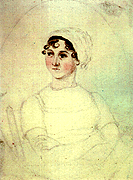Guest post by Conseula Francis and Alison Piepmeier
Conseula Francis blogs at Afrogeek Mom and Dad. In her real life she’s an English professor with a James Baldwin fetish.
Alison Piepmeier blogs at Baxter Sez. She read Pride and Prejudice once…a long time ago…and has very lowbrow taste in movies.
Alison:
This film is an homage to birth control.
No, really—one of the subtexts that Conseula and I both noticed was the fact that, as a woman, your life is much more difficult if, as Jane Austen’s sister puts it, you’re having “a child every year. How will you write?â€
How, indeed.
The homage to birth control is especially poignant because this film is—at least in its first half—unbelievably sexually fraught. And hot. It’s a shame that Conseula and I are both married to other people, because otherwise, we both would have gotten lucky after seeing this film. Whew.
Conseula:
Alison, as usual, is incredibly inappropriate. But she is right. “Becoming Jane†is ultimately about passion—passion for work, passion for life, passion for other people. And it is also about the sacrifices and responsibilities that often make a living a passionate life impossible.
Alison:
Although Conseula would like to take us into a more appropriate train of thought, I’m taking us back to the sex. This film did a great job of letting the audience experience the sexual tension in very subtle interactions—the unexpected meeting at a ball, a conversation ostensibly about literature in a private library. In fact, Jane and Tom’s first kiss, and what Conseula calls their “sneaky hand touches†are far sexier than many explicit scenes I’ve seen in other, less carefully controlled films.
And when Tom and Henry (Jane’s brother) take off their clothes to go swimming in the river after a very flirtatious cricket game, the audience gasped in delight.
Oh, and let me not forget to mention one of the sneaky—but not so subtle—sexy touches in the film happens in the first three minutes, when the Rev. Austen slides under the covers to go down on Mrs. Austen. I love that James Cromwell.
Conseula:
In addition to being incredibly sexy, though (and it was sexy—the actors portraying both Tom and Henry are nothing short of eye candy), the cricket scene also reveals one of the film’s primary themes: the restraints of propriety on 19th century women. As Tom and Henry race from the cricket field to the river, Jane and Countess Eliza (Jane’s cousin) are racing after them, just as alive, just as turned on by the freedom of it all.
But then the boys strip, propriety (as well as other things) rears its head, and Jane and the Countess head back to join the others. The audience is reminded that their freedom is severely constrained, particularly if they hope to marry well.
Alison:
One thing this film does very well is convey the sense, the experience, of those constraints. I could feel myself as a modern audience member searching for the loopholes, the ways that Jane could get out of those constraints and make exactly the life she wants for herself, find ideological and professional (and sexual) gratification. The film knew that I was looking for the loopholes and showed me exactly how they were all closed off for Jane—and, to a lesser extent, for Tom, as well.
Conseula:
It’s difficult to say more about the film without spoiling readers. Though we go into it knowing how the story ends, the journey is, nonetheless, worth it. Instead, I’ll talk about the people in the theater tonight.
We saw “Becoming Jane†at our local “art house†theater and the crowd was typical for such a venue. Well dressed patrons ordering pinot grigio to go with their popcorn. The audience was made up primarily of groups of women, seemingly bonded by their love of Jane Austen and Pride and Prejudice (if the little squeals of delight that erupted every time an allusion to that novel was made is any indication). They were also a few dour looking men attendance, but they didn’t say much.
Alison:
Also, Conseula was the one black person in attendance. Which leads to this important sociological query: why do black people hate Jane Austen?
Conseula:
Given the fact that I actually went, willingly, to this movie and own the A&E production of Pride and Prejudice (Mr. Darcy!), I think we can’t make the sweeping statement that black people don’t like Jane Austen. Maybe they just don’t like pinot grigio with their popcorn.
*With all due respect to Lisa Johnson, whose book of this title is not about Jane Austen.








